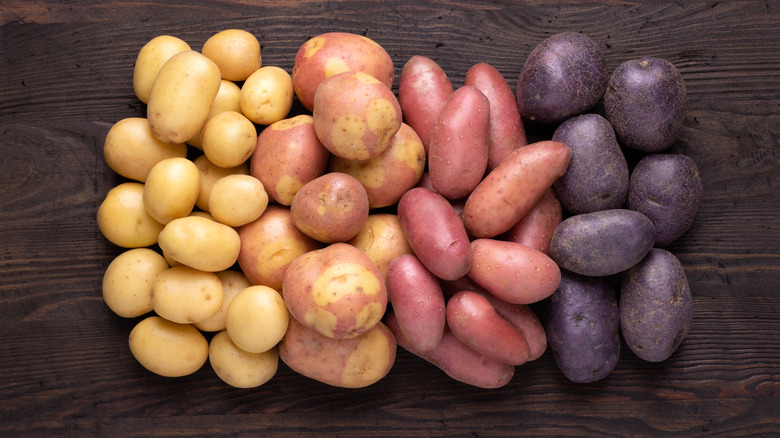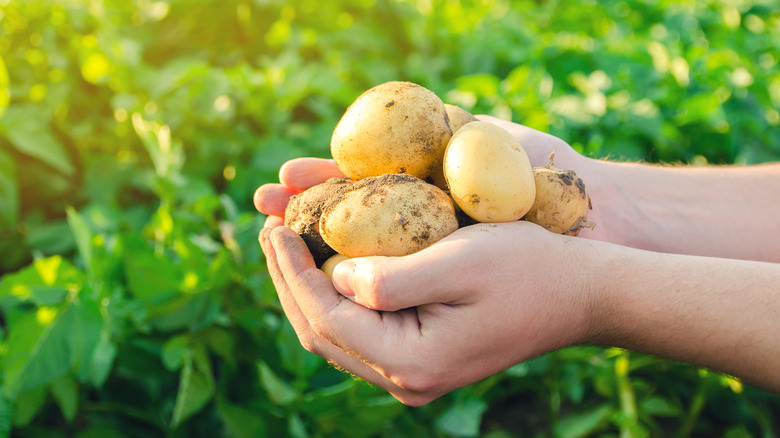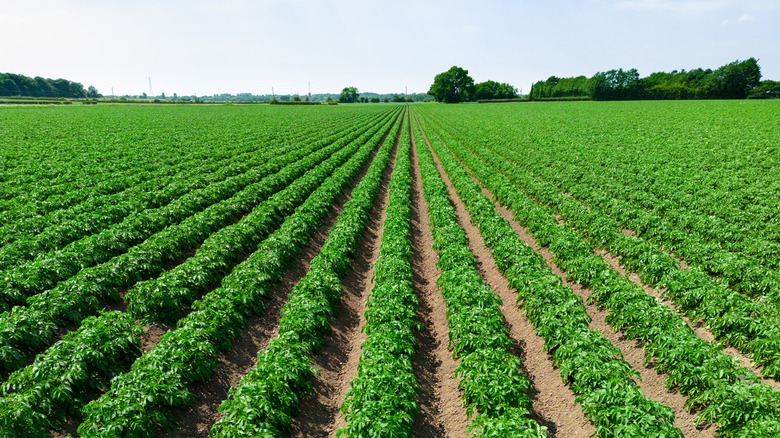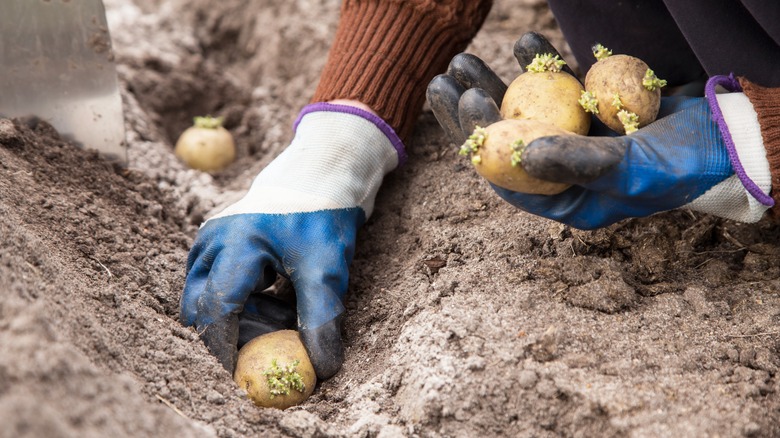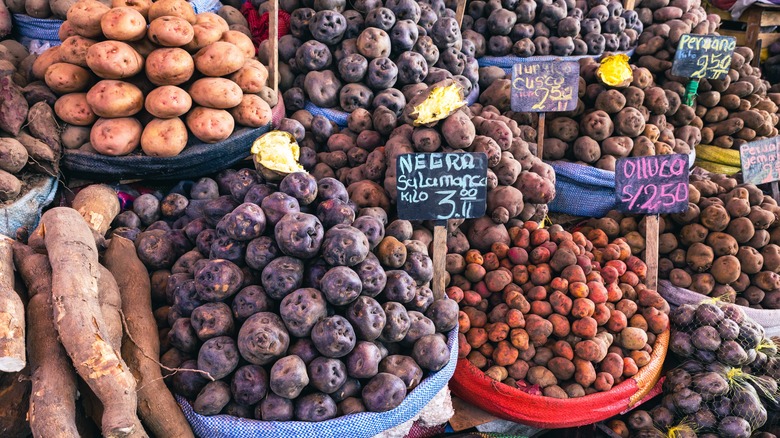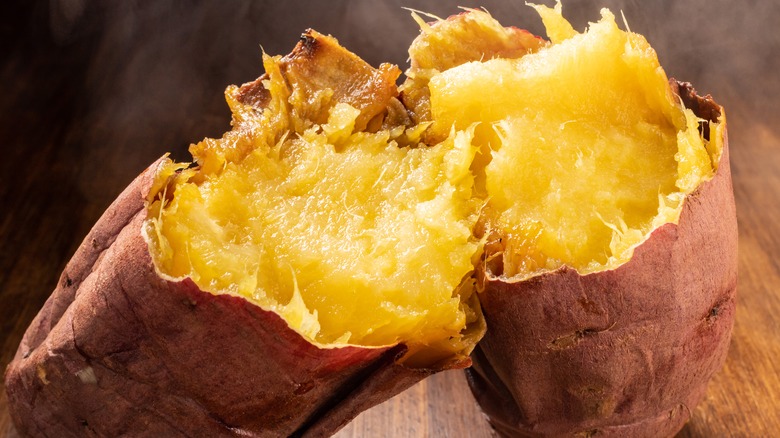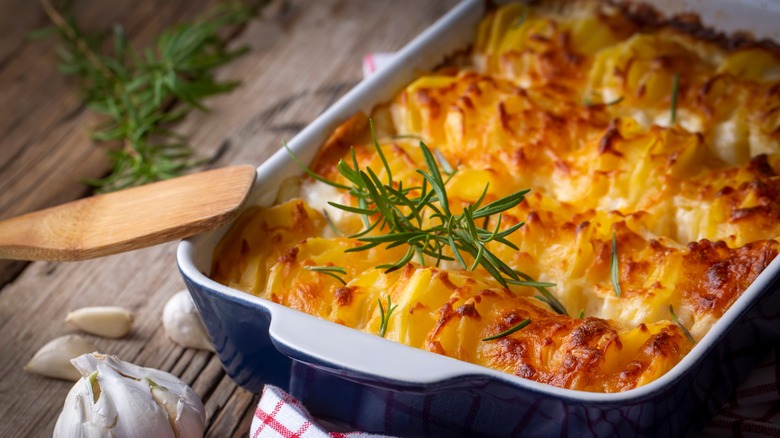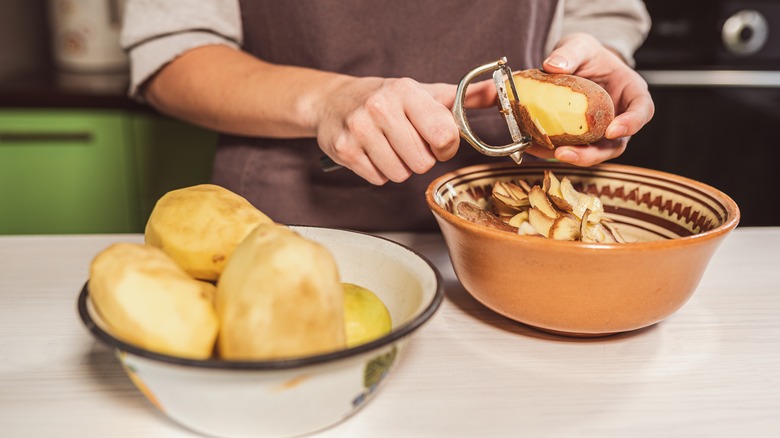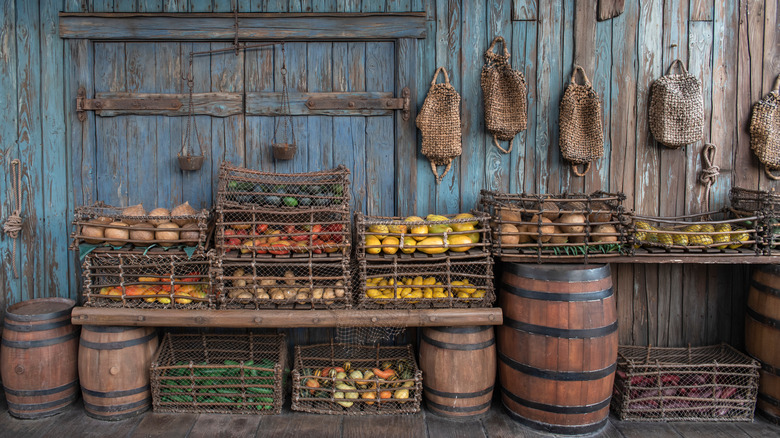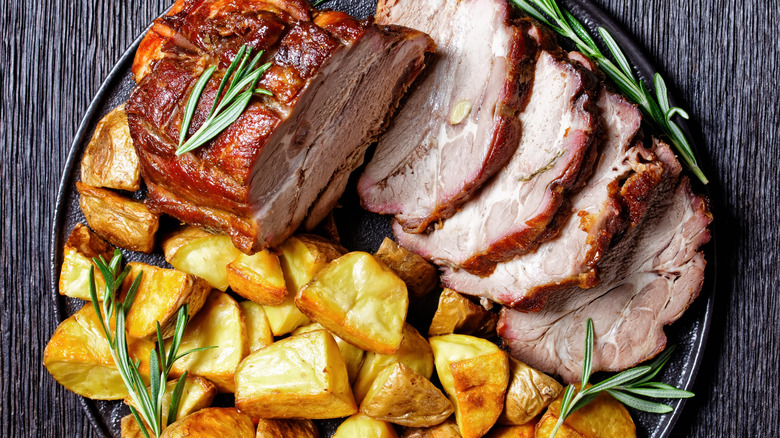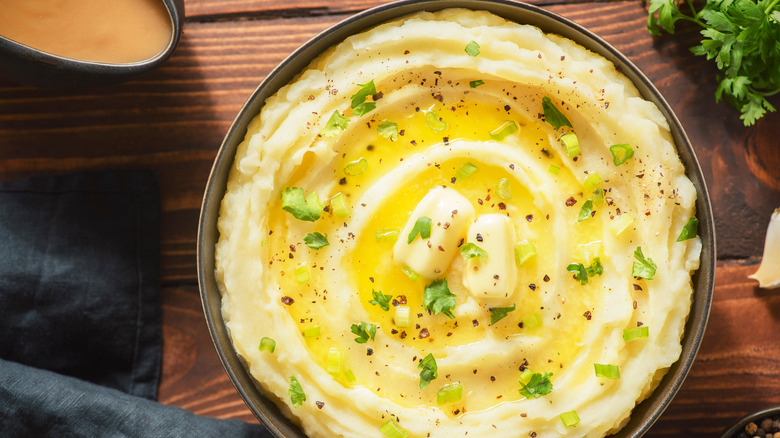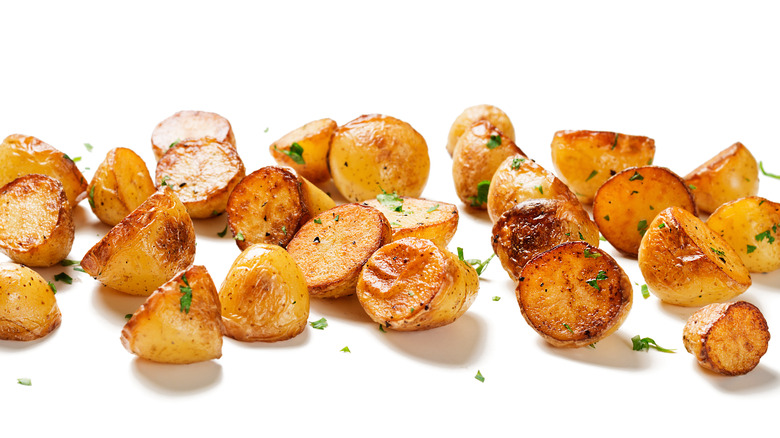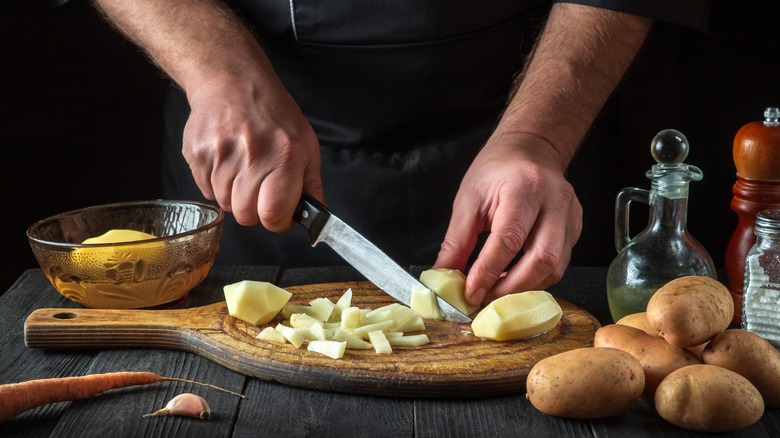Everything You Ever Wondered About Potatoes
Whether baked, mashed, fried, or scalloped, potatoes probably make up some portion of your overall diet. You're definitely not alone: All across the country and around the globe, potatoes are an important dietary staple that can be enjoyed in a variety of ways.
Potatoes are a type of tuber, which is the top portion of an underground stem that stores nutrients, (per All Things Nature). Other types of tubers include sweet potato, yam, cassava, taro, and sunchoke, according to Modern Farmer. While in recent years potatoes have developed somewhat of a bad rap due to their high carbohydrate content, (via USA Today), nutritionists still generally recommend eating them anyway as they are also chock full of essential fiber, vitamins, and minerals.
There are many reasons to love potatoes. Along with being nutritious, they are also delicious. And perhaps best of all, potatoes are extremely versatile from a culinary perspective. Below, we cover everything you ever wondered about potatoes, along with a few things that probably never even crossed your mind.
Potatoes are a major food staple in many countries
Potatoes are a major food staple (the dominant source of dietary nutrients for the population) in many countries. Other important food staples around the world include rice, corn, wheat, and other types of roots and tubers. While the origin of the potato lies in the Americas –– in the Andean highlands region of Peru to be exact, according to Smithsonian Magazine) –– potatoes became a global staple when Spain brought them (along with tomatoes, avocado, and corn) to Europe in the mid-1500s. Within Europe, Ireland's climate was particularly well suited for cultivation. As a result of the potato's valuable nutritional content, its popularity continued to spread. Potatoes are now grown in approximately 125 countries, (per Idaho Potato Museum).
Although plain potatoes can provide almost all the nutrients needed for survival, there's little doubt that potatoes taste better in combination with other ingredients. We are especially partial to adding butter, cheese, and sour cream, but there are many ways potatoes are eaten around the world. Notable international dishes include Jewish latkes, Italian gnocchi, Indian masala dosa, Swedish Hasselback potatoes, and Belgian fries. Yum!
Potatoes are grown in all 50 states
We were surprised to discover that potatoes are grown commercially in a whopping 30 states, along with being grown in commercial and non-commercial ways in all 50 states, (per Idaho Potato Museum). Although Idaho takes the win (by far) for growing the most potatoes in the country, top domestic producers also include Washington, North Dakota, Wisconsin, and Colorado, (via Agriculture Marketing Center).
The United States is the fifth largest potato producer in the world, behind China, India, Russia, and Ukraine, according to the Agriculture Marketing Center. And let's just say that it's a good thing potatoes are so readily available here since Americans eat an awful lot of potatoes. A recent forecast by the U.S. Economic Research Service estimated that each person in the U.S. would eat 115.4 pounds of potatoes in 2015. This estimate included a breakdown by type, with frozen potatoes being the most common (49.7 pounds), followed by fresh potatoes (34.1 pounds). The U.S. Department of Agriculture points out that frozen french fries comprise about ⅓ of potato use in the United States. These are mostly used in the food service industry.
You can grow potatoes from potatoes
When it comes to growing potatoes, you don't need any special seeds or plants to get started. In fact, it is possible to grow potatoes from, well, potatoes. First, find a sunny spot with loose and well-drained soil for your potato patch. While you can plant small potatoes whole, be sure to quarter the larger ones. Next, make sure that each potato (or piece of potato) has an eye (or bud) on it, then let them dry out for two days before planting. Finally, plant your potatoes several inches deep, in rows that are 12 to 15 inches apart. When shoots eventually emerge that are 8 to 10 inches tall, you should "hill" (or mound) soil around the plants to obtain a better crop.
Although the best time of year to plant potatoes varies based on climate, potatoes are best grown in cool weather, with a soil temperature of 50 F or higher. If all goes well, your crop should be ready to harvest within 70 to 100 days. Good luck!
There are over 1,000 varieties of potatoes in the world
If you've only ever eaten Russet (Idaho) potatoes, it may be time to open your eyes to the wider world of potatoes. According to the Wisconsin Department of Public Instruction, you can find 1,000 potato varieties globally, with 100 of these grown right here in the US. Potatoes are generally divided into two main categories. "Floury" (or starchy) potatoes like Russet potatoes possess scaly skin. "Waxy" potatoes have thinner skin and include red, white, and yellow varieties.
If you aren't sure when to use different types of potatoes, our food experts have some thoughts. Go ahead and use Russet potatoes for baked, mashed, and french fried potatoes. Yukon Gold, another type of versatile potato, can be used for mashed potatoes, potato salad, or Spanish-style potatoes. If you prefer smaller potatoes, French fingerlings are great for boiling, roasting, and making potato salad. These buttery potatoes also work well in soups. Bottom line: There's a potato out there for everyone. We suggest a little experimentation to figure out which type of potato to use for your favorite potato dish.
Sweet potato is not a potato
It's a question nearly as old as time: Are sweet potatoes really potatoes? Despite the misleading name, you should be aware that a sweet potato is not actually a potato. While both potatoes and sweet potatoes are types of tuber, sweet potatoes come from the root of a plant in the morning glory family, (via Farmer's Almanac).
Another common source of potato confusion involves sweet potatoes versus yams. In the U.S., these two terms are often used interchangeably –– but that doesn't mean they are the same thing. Sweet potatoes typically have orange innards, surrounded by gold, copper, or bronze skins, and are moister than yams. Yams (or nyami) derive from Africa and possess bark-like skin that is darker and more similar to yucca than either potatoes or sweet potatoes. Their insides can be white, purple, or red and are generally on the drier side for tubers. Although there are an estimated 200 types of yams in the world, you won't find any that are grown commercially domestically.
Potatoes can be prepared in many ways
As mentioned previously, potatoes are an incredibly versatile food. Some common potato preparations in the U.S. include french fries, mashed potatoes, roasted potatoes, baked potatoes, scalloped potatoes, potato chips, and potato salad –– but don't let us stop you there. You can also boil them, make potato-based soups, experience cheesy potato gratin, twice-bake your potatoes, eat a hash brown casserole for breakfast, or enjoy countless other delicious potato recipes at any time of day. If you want to go global with your potato recipes, try making Vichyssoise from France, masala dosa from India, or patatas bravas from Spain. Hey, the world's your potato!
Some of our favorite potato recipes include crispy-edged smashed potatoes, potato pancakes (latkes), and creamy garlic mashed red potatoes. If and when you're ready to branch out and develop your own potato creations, be sure to first check out our recommendations for upgrading mashed potatoes and hacking your roasted potatoes to perfection. Or if you prefer to keep things more basic, you can always microwave a potato, cut it in half, and top it with butter, cheese, sour cream, and bacon bits. It's hard to go wrong.
You can peel a potato with or without a peeler
There are two main ways to peel a potato: with or without a peeler. To use a peeler, first, wash raw potatoes with cold water. Then, use the end of your peeler or a small paring knife to remove any eyes (buds, sprouts). Hold a potato with one hand and peel it using the peeler with the other hand, using downward motions. Finally, rinse the potatoes to remove any residue. If you don't have a potato peeler, you can also use a paring knife. In this case, use slow and careful peeling motions toward you.
You can also peel your potatoes without a peeler, which involves boiling them prior to peeling. For this method, first, wash raw potatoes with cold water. Then, use a paring knife to score the skin in a shallow line around the circumference of each potato. Next, carefully drop the potatoes into boiling water and cook until tender. Transfer to a colander, rinse it with cold water, and then slide off the potato skins. They should come off easily, but if needed, you can use a paring knife to help cut them away.
If you're wondering what to do with leftover potato peels, we think they're pretty delicious when baked with a little olive oil and salt, but you can also load them up with cheese, bacon, sour cream, and green onions.
Potatoes can last several months when stored properly
Another great thing about potatoes is that they can last up to several months when stored properly. Keep in mind that potatoes will last longest at home when they are fresh when purchased, so be sure to check for and avoid those with bruises, eyes/buds, and sprouts. These are signs of impending spoilage. (Potatoes with sprouts can still be eaten if the sprouts are removed –– but don't delay.) Fresh potatoes should be firm when you squeeze them. An ideal storage temperature is between 45 F and 50 F.
Store whole, raw potatoes in a cool, dry place away from sunlight –– such as in a pantry or cellar. Avoid sealing potatoes in airtight bags or containers, since tubers do best with good air circulation around them. You should also keep potatoes stored separately from other vegetables and fruits. And finally, although you may be tempted to store your potatoes in the refrigerator or freezer (after all, it is cool, dry, and dark in there), this storage method can result in soft, brown potatoes with increased levels of sugar and acrylamides (a potentially dangerous compound that can occur when starchy vegetables are cooked). Cooked potatoes, on the other hand, can be stored in the refrigerator for three to four days.
Many foods pair well with potatoes
While there's absolutely nothing wrong with eating potatoes on their own, potatoes pair amazingly well with many other types of food. Potatoes can be key ingredients in either main courses or side dishes, depending on your preferences. Best of all, you can eat them at any time of the day –– for breakfast, lunch, or dinner. You can even snack on them –– because who doesn't love potato chips?
For breakfast, consider making a slow cooker breakfast casserole overnight or getting up early to cook up some hash browns and eggs with a side of bacon, sausage, or fresh fruit. For lunch, try a potato-based soup in a bread bowl with a side salad, or make your favorite sandwich to serve with potato salad. For dinner, potatoes –– prepared in just about any way –– make a great accompaniment to seafood, poultry, or meat dishes. They also go great with other types of vegetables, including Brussels sprouts, mushrooms, carrots, and onions. And, of course, you can always go with one of America's favorite meal combos: a burger, milkshake, and order of french fries.
If you're a fan of dairy products in general, potatoes may just be your new best friend. They make a fantastic base for butter, sour cream, and cheese, so gear up for some calcium and vitamin D infusions, along with the many nutrients in potatoes themselves.
There are many cooking techniques to elevate basic potatoes
If you used to think that potatoes were boring, we sure hope you're starting to see their full potential. Perhaps the most important takeaway here is that there are many different preparation methods that can take plain potatoes from basic and palatable to delicious and downright gourmet.
Let's start with baked potatoes. If you've only ever popped them in the microwave or wrapped them in foil for oven roasting before, you haven't yet experienced how crispy and yummy they can be. So here's a hack for a crispier baked potato: Forgo the microwave or aluminum foil, wash your potato well, roll it in salt, and place it directly on the rack in a preheated oven (up to 430 F). You can thank us later.
As for mashed potatoes, don't just boil them, mash them, and complain that they are bland. Instead, jazz them up a little. In a recent survey of mashed potato lovers, we discovered that the No. 1 desired upgrade is butter. This beloved add-in was followed by sour cream, roasted garlic, cream cheese, mayonnaise, and chives. Of course, there's no reason to limit yourself to just one of these add-ins. Use as many as you want to create a customized mashed potato dish that exactly suits your palate.
There are hacks to roasting the perfect potatoes
If you love roast potatoes but can't seem to get them quite right at home, we can help. We understand all too well the disappointment of removing undercooked potatoes from the oven or, even worse, discovering that your supposedly roasted potatoes are steamed and mushy instead of brown and crispy.
Here are some of our favorite potato roasting hacks, which start with using the right type of potatoes. We suggest avoiding starchier varieties and using waxy or hybrid potatoes with thin skins, such as fingerling, red bliss, German butterballs, or Yukon golds. Next up: Parboil the potatoes before roasting them. This involves boiling your potatoes in salted water (or water with baking soda) for about 10 minutes or until the center is tender.
Additional hacks for making perfect roast potatoes (and other vegetables) include making sure that they are dry before placing them in the oven, along with giving them plenty of space on the pan. Preheating the pan can also help produce crispier results.
Vodka can be made from potatoes (though it usually isn't)
While it is true that vodka can be made from potatoes, this method isn't all that common. According to Liquor Laboratory, only about 3% of the world's vodka is actually made from potatoes. More often, wheat or grain is used in the production process. Vodka can also be made by fermenting and distilling rice, corn, beets, honey, fruits, and other agricultural products.
Indeed, vodka can be made from almost anything, so long as it contains sugar and starch. Vodka also contains about 60% water, so the quality of the water itself can have a profound impact on the end taste. Most high-quality vodkas are made from spring or glacial water sources. The word "vodka" is derived from the Slavic word "voda" (water), which makes a lot of sense with all of this in mind.
Although vodka was originally only used medicinally because it tasted so bad, its flavor has improved through the centuries. Vodka is now the best-selling spirit in the United States, making up about ⅓ of cocktail sales.
Potatoes offer a range of health benefits
Not only do potatoes taste good, but they are also good for you. According to Medical News Today, eating potatoes can benefit your bones, blood pressure, heart health, inflammation levels, cancer risks, digestion, weight, metabolism, skin, and overall immunity. Potatoes are full of fiber, which can keep you full. Eating enough fiber has also been linked to lower cholesterol and blood sugar levels, which may help prevent heart disease. Potatoes are also a good source of potassium, an essential nutrient for the entire body. Potassium helps normalize fluid levels within our cells, (per Harvard T.H. Chan School of Public Health).
When it comes to eating potatoes for better health, there are some catches. If you want to experience the associated health benefits, you will need to avoid unhealthy french fries, along with limiting certain add-ins like butter and sour cream. These items can quickly lead to weight gain, diabetes, and other health issues, so it is important to use them sparingly in your diet. Potatoes also have a high glycemic load, which can be problematic for some, (via Harvard T.H. Chan School of Public Health).
Still, when prepared in health-conscious ways, the potato can be an important and healthy part of a balanced diet, according to Live Science. On its own, a medium potato contains about 110 calories, 0 grams of fat, and 2 grams of fiber. It also provides a number of important vitamins and minerals.
Potatoes can be grown in space
If you've seen Matt Damon in the movie "The Martian," you may remember how his character –– an astronaut mistakenly left behind on Mars –– manages to survive by eating potatoes grown in his own, well, fertilizer. While this Martian scenario was entirely fictional, the concept of growing potatoes off-planet is actually based on reality.
The potato was the first food to be successfully grown in space. According to NASA, the technique was first tested in 1995 as part of NASA's space shuttle program. These days, astronauts on the International Space Station (ISS) can eat tubers and other vegetables grown right there on board.
We are going to leave you with one last intergalactic potato fact: Potatoes even played a role in Star Wars. Do you recall the Hoth asteroid field in "The Empire Strikes Back"? Those asteroids were partially made from potatoes, (via the McGill Office for Science and Society). May the potato be with you.
